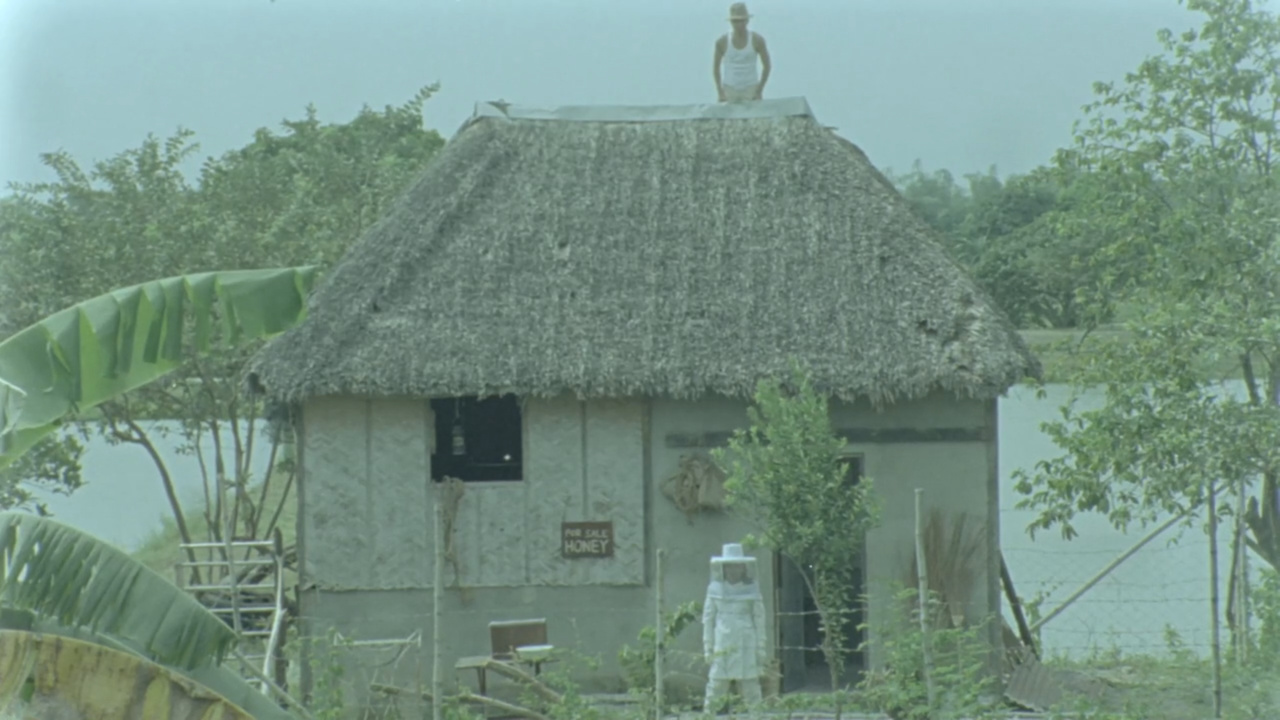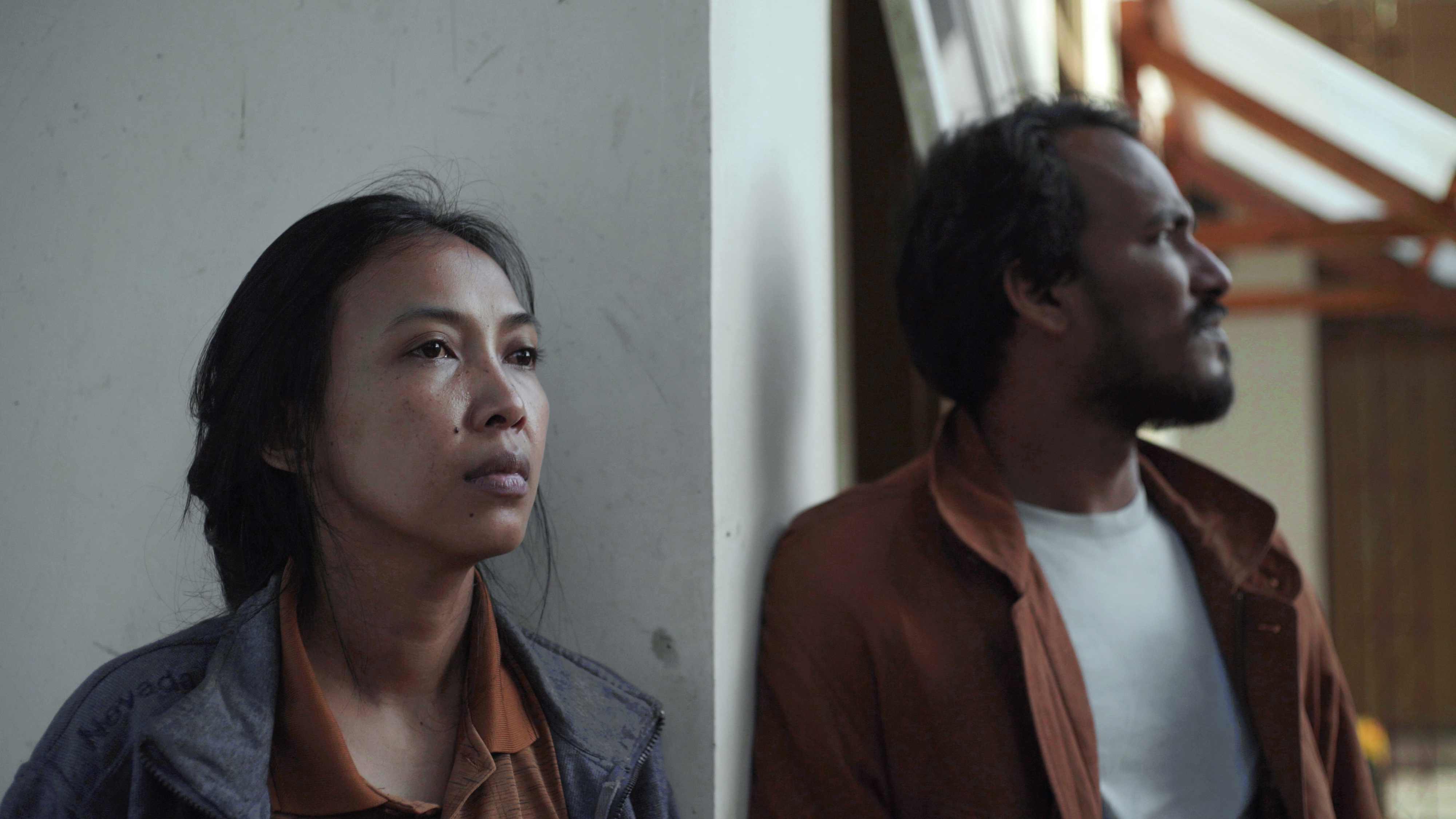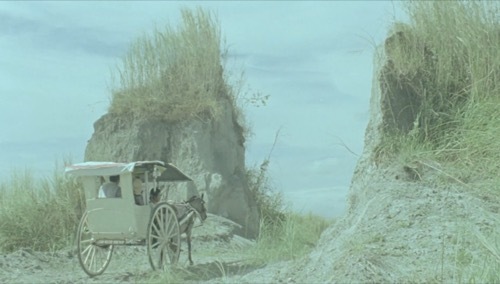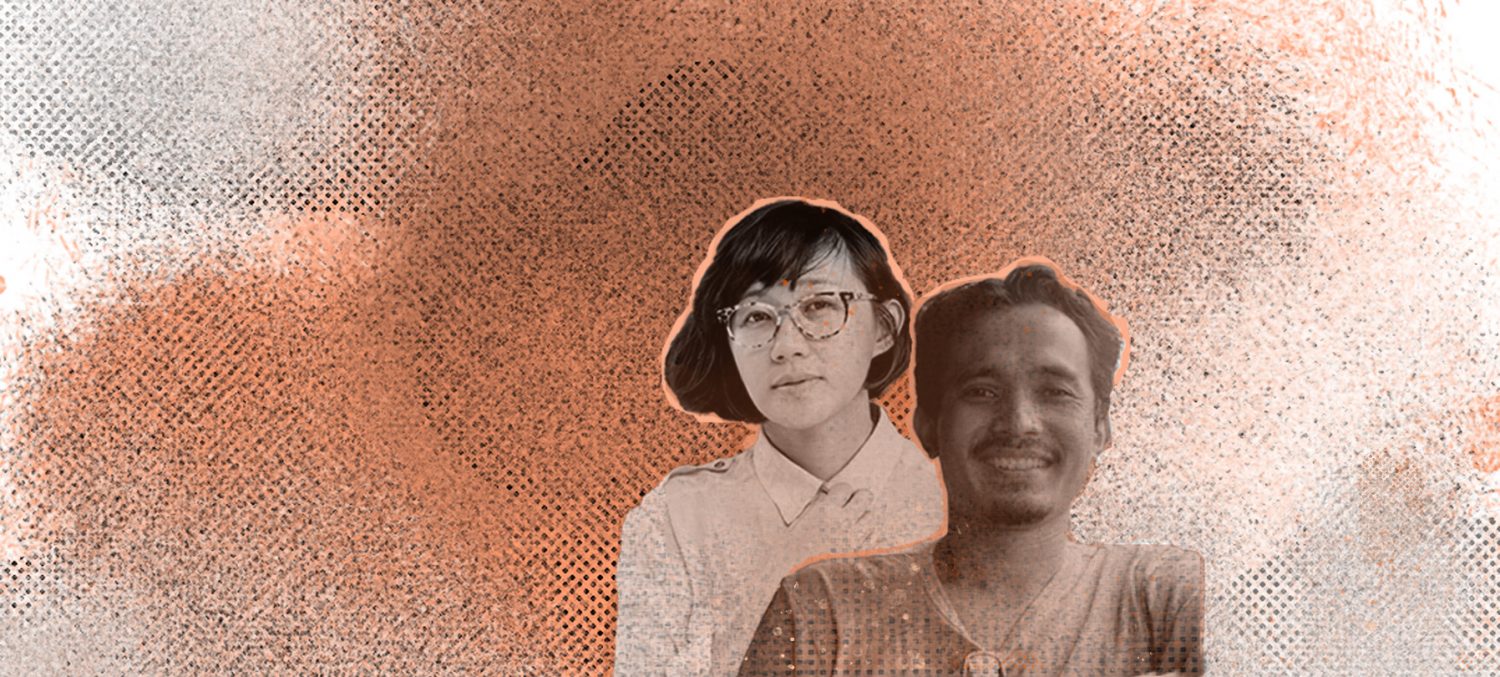Part of the Objectifs Short Film Incubator 2021
The third Objectifs Film Club session of 2021, presented as part of the Objectifs Short Film Incubator 2021, featured the incubator’s mentors, filmmakers Shireen Seno (the Philippines) and Yosep Anggi Noen (Indonesia) in conversation, with Leong Puiyee from Objectifs as moderator.
Read on for a recap of their discussion on religious beliefs and myths in relation to their respective works Shotgun Tuding and Ballad of Blood and Two White Buckets, how they straddle between the short film and feature film formats, and the stories they would like to continue to tell as filmmakers. The conversation has been edited for brevity.
Puiyee: Shireen, your short film Shotgun Tuding is described as a “pancit western”. Is this genre very specific to the Philippines and was it influenced by American Western films?
Shireen: Pancit is like a national noodle dish, like our version of spaghetti. Pancit westerns became popular in the 1970s as our own kind of action-comedy variants on westerns. I grew up watching Hollywood westerns due to my dad’s eclectic taste in films. I became curious about pancit westerns when embarking on this film and learnt so much about Philippine film history from a blog called Video 48. It is a treasure trove for film enthusiasts.
Audience Member: Shireen, what made you want to take up genre filmmaking, and what prompted you to write this story?
Shireen: I made Shotgun Tuding after my first feature film Big Boy. I had fun making Big Boy but it was a serious film, a tragicomedy. I wanted to have fun again. We were all quite young and free, shooting Big Boy on Super 8 film, which we loved, so I decided to shoot Shotgun Tuding on 16mm film. I co-wrote Shotgun Tuding with Timmy Harn, who also worked on Big Boy.
I was exposed to the pancit western genre mostly through YouTube. The copies there were made from another medium like DVDs, VCDs or VHS, so the footage had particular textures that I liked, so I chose to use film.
Shotgun Tuding was commissioned by a group in Malaysia called WOMEN:Girls. They were looking for someone from the Philippines for a Southeast Asian omnibus so they asked me to make a short film and gave me funding. There was a lot of freedom though it was a strange experience making it in relation to their idea of an omnibus of films by women, because I’d never really made things for a certain kind of cause or audience.
I always try to start making things from personal stories, personal histories and even myths. I grew up in Japan quite removed from my extended family so each time they tell stories, I really listen. My grandfather was a soldier in WWII fighting on the side of the Americans and when on the island of Mindoro, he got involved with someone, and she got pregnant. Their first son was my dad. I decided to mix the pancit western genre with the story of my grand aunt who tried to hunt down my grandfather to get him to marry her sister, as it was taboo to have a child out of wedlock. I wanted to highlight the determination of this woman in taking care of her younger sister.
Audience Member: Shireen, what do you think is the difference between pancit westerns, satay westerns and spaghetti western films?
Shireen: I haven’t watched a satay western but would love to. Our pancit westerns are very slapstick. We already had such comedy but it was about putting on the guise of a western; the environments, the props are all kind of transplanted to a desert environment. Interestingly, we shot Shotgun Tuding in an area north of Manila which was the site of a big volcanic eruption in the 1990s and a lot of towns were buried in ash. I tend to go through a lot of archival photos when researching for films and I found many photos of houses where just the roofs are showing. I tried to recreate that at the beginning of Shotgun Tuding. It’s quite a tragic kind of location but also became the location for pancit westerns in the 1970s because the ash is very powdery, almost like sand.

Still from “Shotgun Tuding” by Shireen Seno
Puiyee: Have your dad and grandfather seen Shotgun Tuding? What were their thoughts and reactions?
Shireen: My grandfather passed away before I made it. My father, when he saw it, said my grand aunt was even more strong willed, more fierce [than I depicted her]. I usually try to work with non actors. There’s only one actor in the film, who has worked on some independent films and in theatre. I worked with him on my first feature and really liked him. The rest are all friends. It’s really fun to just feel free, get a kick out of this genre, and make my own version of it.
Puiyee: It sounds like a wonderful experience. Anggi, your short film Ballad of Blood and Two White Buckets revolves around religious beliefs and myths, and features a couple selling congealed blood. Can you tell us more about that practice?
Anggi: Here in Indonesia, there has been a rise in people who politicise religion. Some of the food we ate 10 or 20 years ago when I was a child, like congealed “jelly” blood, could be found everywhere. We could ask for it in small stores and it was mixed with other food. But sometimes this food is considered haram (forbidden, or unlawful). It has become not about whether the food is haram for the person consuming it or not, but about how people react when they see it. My family is Catholic and we can eat this without any religious restrictions.
Almost 20 years ago, a couple often came to our home riding a bicycle and sold us this jelly blood from a bamboo box. My mother would often buy it and we cooked it for dinner. I liked it. But after some time, they didn’t come again to our house. When I went to university, I would ride my motorcycle from the village to the campus via a regular route. After five or six years, I saw the couple still selling the blood jelly. They were still using the same bicycle, the same box…it seemed their lives hadn’t “upgraded”. Because of pervasive beliefs, the couple had missed out on chances to improve their lives. Politics in Indonesia is changing with an increase in the number of fundamentalist people involved. I also put this in the film.
Making the film was very easy. I shot it in my mother’s house. The animal market is not far away from there. I often arrive at a place, observe the situation and then decide to film there. The market is only open twice a month so we had a tight schedule to shoot. if I didn’t have the right schedule, it might get expensive. Like Shireen, I too made this film after a feature (my second); it was relaxing.
Puiyee: It seems you both make feature films, but always go back to making short films as well. As filmmakers do you also feel the kinds of stories or the way you want to express yourselves can only be done in a particular medium?
Shireen: It’s gruelling making a feature. You have to dig through so much — not just creatively, but even raising money can take so long, sometimes it kills you to just wait.
It’s much more fun to make shorts because there’s much less pressure. Making shorts is a way to just express and let ourselves make with many less restrictions. It’s liberating to put in place limits too though, and not just go on and on but to make them as tight as you can.
After my second feature Nervous Translation (2018) I enjoyed going back to shorts and made two more. I felt happy because I had more ownership of them. With features, it isn’t even in my hands where they go. For shorts, I’m able to get my own screening fees as well, which is really nice.
Anggi: I agree with Shireen. Short films are liberating. They make me feel I can do anything I want. When I make short films I’m always thinking about upgrading my skills and trying something new. In feature films, that’s a problem because experimenting means spending much more money. If you watch some of my short films, I never repeat the same style, though of course some of the essence is still there.
I made one of my short films on an island far away from Java. I travelled there with money I received from a museum to make this work. When I got to the island, I didn’t know what to make so I spent two weeks in the hotel, and went around on my motorcycle. Eventually I made a black-and-white genre film which has travelled quite a bit. It had fresh elements in it. I made another short film in the rice field two minutes’ walking distance from my mother’s house.
If you want to make feature films, you need to prepare. Programmers at international film festivals want to see your finest work. But my suggestion for everyone who wants to make short films is: “With what you have, simply make do.” Keeping your idea on a sticky note won’t get you anywhere.
Assess what resources you have, your potential, and what is limited. Write in a simple way, pick up your camera and just make the film with what you have now. And then don’t just keep it in your hard drive. Show it to people. I call this being calculated, and then impulsive.
Puiyee: You’ve both been making films for so many years, exploring different types of stories and genres. As you continue in your filmmaking journeys, are there particular types of stories you feel you haven’t explored yet?
Shireen: I’m trying to write another feature now but haven’t got far yet. It has a western feel to it, but also goes back to a family story, of my dad who migrated to the US in the early 2000s. He doesn’t talk much, so sometimes I hear his stories through my mom. I initially wanted to shoot it as a short — just this one episode in his Los Angeles life, and I wanted my dad to play himself but he’s getting old so I don’t think it’ll be possible. But now I’m trying to gather more stories and weave something out of it.
Features are difficult for me. I get stuck, I get bored of myself and don’t push myself enough. So I do other things. I was commissioned by a photographic museum to make a short work on the early American period of the Philippines, by going into the archives. There are a lot of photographic archives online for Philippine photography, mostly in the US, because our colonisers were able to “take care” of all the negatives.
Anggi: I aspire to be open to any kind of genre. I’m now working under a big studio in Indonesia to make more commercial films including one adapted from a popular independent book. I’m still fighting to keep my style but as there is a big company backing it, there will be more negotiation, of course.
I also want to make action films with blood, violence, some guns! I’ve made three feature films but their style attracts a tiny audience. I love doing it but after three such films I want to make something that actually attracts one or two million people to come see my film in cinemas.
Audience Member: Anggi, what sensation did you want audiences to experience with the coughing character in your short film?

The protagonists of Anggi’s short film “Ballad of Blood and Two White Buckets”
Anggi: I wanted to make people feel uncomfortable. My hypothesis is that film can create a bodily reaction. For example, like porn films, or crying in films. Upon watching the character coughing, the audience would probably feel discomfort in their throats. When the film showed in Toronto, people in the audience kept clearing their throats and making cough noises. One reaction followed by another. It was fun. I enjoyed it as part of my experimentation.
Puiyee: The film also touches on politics in Indonesia. How did local audiences react or feel about the film, versus international audiences?
Anggi: Of course people in Indonesia related to the story more than international audiences, as they could connect with the situation. Some commented on the politics and got into it.
However, audiences in Indonesia enjoy narrative films. I feel this film is actually very narrative but some people still want to get even more story, than sensation. It wasn’t a popular film in Indonesia. It would attract maybe 10,000 or fewer viewers on YouTube, I’m sure. Some other kinds of films would get 25m, 30m viewers.
Audience Member: Both of your films are based on real personal experiences but captured in very imaginative ways. What is your working process for transforming real experiences into a fictional idea? How do you maintain the core of the story in the development?
Anggi: I don’t believe in tips and tricks. Each filmmaker has their own approach. But research is part of how I develop some of my personal experiences. I try to identify what is going on recently, something that has impacted society.
For example, Ballad of Blood and Two White Buckets is based on my personal experiences back in 2010. So the question is, what has happened since, and what is happening now, in society? This led me into further research and I made connections. I still kept in the personal statement I wanted to make, but that always depends on what is going on now in society. Contextualise.
Shireen: Many of my films come from very distant places like hearsay, or family stories…not stuff I experienced firsthand. I like that they’re very fragmented, because it gives me a lot of freedom to fill in the blanks. I try to keep the mystery there but to add some flesh to it so it’s more than just the skeleton.
It’s about making it my own. It comes from some other place and then I try to put more of myself in there. I try to excavate and call other sources, talk to other people. A couple of my films are period films. A lot of it is about talking to people about that time but also giving my own take on that period too.

From “Shotgun Tuding” by Shireen Senofb
Audience Member: Both your films are inspired by real people you know. Did you have any dilemmas about their privacy or about representing them in the correct way?
Shireen: It’s quite a personal story but I used the pancit western genre to give it a different lens. I’d have had trouble shooting it like a raw documentary. I try to use different lenses. At other times it’s been a period film, a child’s point of view…
Anggi: As storytellers, these personal dilemmas occur not only when the story is based on real events but even for stories that are 100% fiction from your imagination, because you put part of yourself into the stories. Take it easy. As long as you’re not hurting people. Go back to what your honest statement is about certain issues that you want to share through the film.
Audience Member: How do you choose titles for your films? Is it a long process or does it come naturally?
Shireen: Sometimes it’s quite hard. Sometimes I start with the title. Shotgun Tuding comes from thinking about shotgun weddings, because my paternal grandparents were made to have a shotgun wedding for my father to be considered a legitimate child, And my aunt’s name is Tuding, so I thought it would be a nice play on “wedding” and to have her carry a shotgun to make her the focus rather than the wedding —to make a strong female character take the lead instead of the actual event.
Puiyee: How about for your feature films Big Boy and Nervous Translation?
Shireen: I was originally going to call Big Boy “Tall Tales” because it involves myths about a family who want their son to be tall. But in the end I went with Big Boy because it was more about a person, or a product, like “big boy growing oil”. For Nervous Translation, I had a dream about the phrase. I was supposed to go to my relatives’ home to find a pen and wondered “what is this?” So I went from there.
Anggi: For some of my films, the titles change when I’m done. My first feature film’s working title was Days of a Red Maroon Sofa but became Regular Vacation and Other Illnesses. In the process of our eight-day shoot my actor got chicken pox. I had changed some dialogue in the script to reference chicken pox, and the day after I did so, the actress got chicken pox! So we stopped the shoot for three months and continued after that. I changed the title to record those illnesses as a part of my process.
For my second feature Solo Solitudes, the Indonesian title comes from a poet. The working title was Days with No Shadows but I changed it in the process. The Science of Fictions is my one and only feature film whose title didn’t change.
For my short films, I like to play with words. I like rhymes. When riding my motorbike or bicycle, an idea for a title somehow appears just in my face and then I make a modification. But my point is that I don’t push myself to get the words. I just go about my casual activities and somehow it just appears.
You can also read our past Film Club recaps here.

